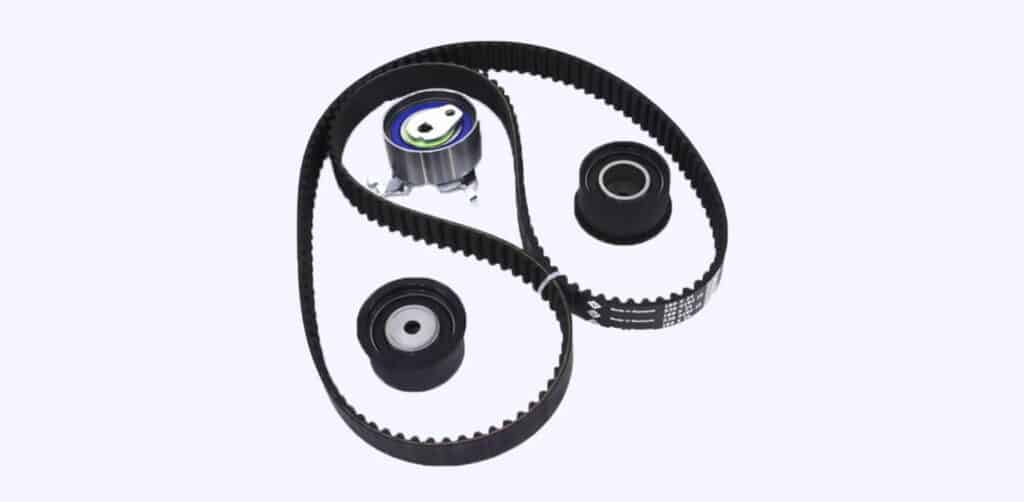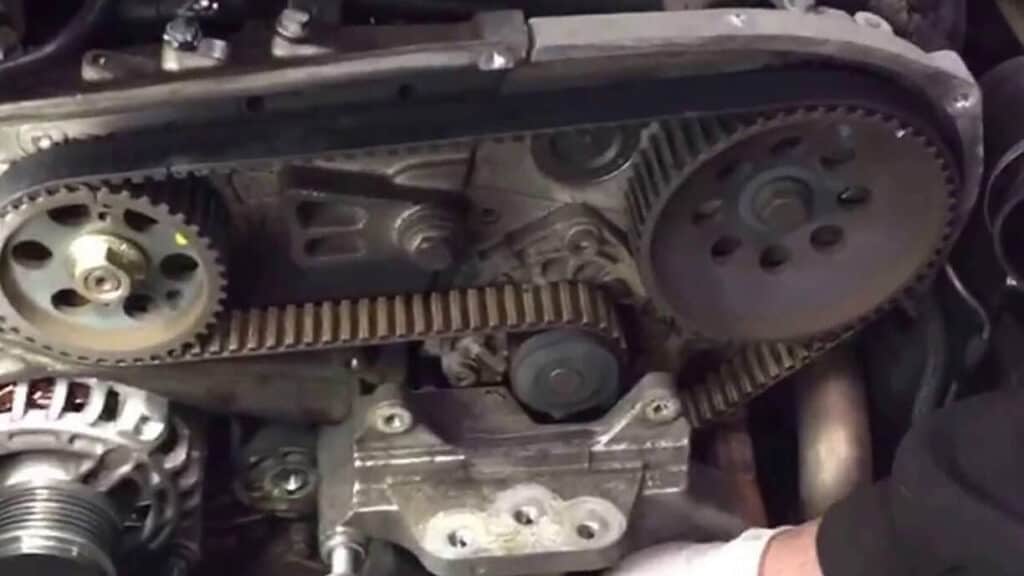Introduction
Just like a finely tuned orchestra requires an expert conductor, your car’s engine needs a timing belt and tensioner to maintain its rhythm. But what happens when the maestro falters?
What is a Timing Belt and Tensioner?
The timing belt is the mechanical maestro of your engine’s performance, controlling the timing of the engine’s valves. It ensures that the intake and exhaust valves open and close at precisely the right times.
The timing belt tensioner, on the other hand, is the unsung hero that maintains the belt’s tension, preventing it from slipping off the pulleys. Without the tensioner, the timing belt would lose its grip, leading to engine failure.
How Much Will it Cost to Replace a Timing Belt and Tensioner in Canada?
The cost of replacing a timing belt and tensioner in Canada typically falls between $600 and $1200. This includes parts, which usually cost between $200 to $300, and labour, ranging from $400 to $900. The process may take around 3 to 6 hours, depending on the vehicle’s model and the mechanic’s experience.

What are the Symptoms of a Faulty Timing Belt and Tensioner?
The symptoms of a faulty timing belt and tensioner can include:
• Unusual Noises: One of the first symptoms that might surface is a ticking or rattling noise coming from the engine, particularly when it’s idling. This is often due to the timing belt becoming loose or the tensioner failing.
• Engine Misfire or Rough Running: If the timing belt is wearing out or has slipped, it could cause the engine’s timing to be off, leading to misfires, rough running, or a lack of power.
• Difficulty Starting the Car: A worn or broken timing belt can make it difficult to start the car as it can cause the engine’s timing to be out of sync.
• Check Engine Light or Error Codes: In some cases, the car’s computer may detect a problem with the timing and trigger the Check Engine Light. A diagnostic scan may reveal error codes related to the engine’s timing.
• Engine Failure or Damage: In the worst-case scenario, if the timing belt snaps, the engine can suffer severe damage, as this may lead to a situation where the pistons and valves collide.
• Excessive Exhaust Smoke: If the engine’s timing is off due to a failing timing belt, it can cause the engine to burn more fuel than necessary, leading to an increase in exhaust emissions.
How Long Does a Timing Belt and Tensioner Last?
Most timing belts and tensioners are designed to last between 96,000 and 160,000 kilometers, but it’s always wise to refer to your vehicle’s maintenance manual for exact intervals.
How Does a Timing Belt and Tensioner Become Defective?
A timing belt and tensioner can become defective due to a variety of reasons:
• Age and Wear: Over time, the rubber in the timing belt can dry out and crack, leading to failure. Also, as the timing belt is used, it can stretch, causing the tensioner to work harder to maintain proper tension, leading to premature failure of the tensioner.
• Heat and Friction: The constant heat and friction generated by the engine can cause the timing belt and tensioner to wear out over time.
• Poor Maintenance: Not adhering to the recommended maintenance schedule can lead to premature failure. If oil or other fluids leak onto the belt, they can cause it to degrade more quickly.
• Defective Parts: Sometimes, the parts themselves might be defective from the manufacturer. This can result in a shorter than expected lifespan.
• Improper Installation: If the timing belt or tensioner is not installed correctly, it can lead to failure. This might occur if the belt tension is not set correctly, causing the belt to be too loose or too tight.
• Engine Overloading: Regularly pushing the engine to high RPMs, or hauling heavy loads, can stress the timing belt and tensioner and cause premature failure.

How Can a Faulty Timing Belt and Tensioner Affect Other Systems in the Car?
• Engine Damage: The timing belt and tensioner are key components for maintaining the engine’s timing. If they are faulty, they can cause significant engine damage, including bent valves, cylinder head or camshaft damage, and even piston and cylinder wall damage.
• Power Loss: A faulty timing belt and tensioner can negatively affect engine performance. If the timing belt slips or if the tensioner can’t maintain proper belt tension, it can lead to a loss of power and decreased overall vehicle performance.
• Alternator and Water Pump Failure: The timing belt is also responsible for driving other parts such as the alternator and the water pump in some vehicles. A faulty belt can lead to these components failing as well.
• Increased Emissions: Faulty timing can lead to inefficient combustion, which can increase exhaust emissions, potentially causing the vehicle to fail emissions testing.
• Breakdowns: A faulty timing belt and tensioner can cause the vehicle to breakdown, leaving you stranded. This could affect the electrical system if the alternator is not being driven properly, causing battery drain and potentially leaving you without power in the vehicle.
Is it Safe to Drive with a Faulty Timing Belt and Tensioner?
It is definitely not safe to drive with a faulty timing belt and tensioner. The timing belt and tensioner play an incredibly vital role in the functioning of your car’s engine. The timing belt links the camshaft and the crankshaft to ensure the engine’s valves open and close at the correct times during each cylinder’s intake and exhaust strokes. The tensioner ensures the belt maintains the right level of tension to do this job effectively. A failure in either component can result in serious engine damage.
If the timing belt snaps or slips due to a faulty tensioner, the synchronization between the crankshaft and camshaft can be lost. This may cause the pistons and valves to collide, resulting in extensive engine damage, sometimes even requiring a complete engine replacement. This is not only a costly repair but can also be extremely dangerous, especially if it happens while driving at high speeds. Therefore, if you suspect a problem with your timing belt or tensioner, it is important to stop driving immediately and get your vehicle inspected by a qualified mechanic.
How Can I Make My Timing Belt and Tensioner Last Longer?
• Follow your car’s maintenance schedule.
• Ensure regular oil changes to prevent leaks.
• Avoid harsh driving conditions, such as rapid acceleration and deceleration.

Can a Mobile Mechanic Replace a Timing Belt and Tensioner?
Absolutely! Many mobile mechanics have the necessary tools and expertise to replace a timing belt and tensioner right in your driveway or at your office parking lot.
Conclusion: Timing Belt and Tensioner Replacement
Don’t let a faulty timing belt and tensioner throw your engine out of tune. Regular maintenance and prompt replacement when needed will not only extend the life of your engine but also prevent the high cost and inconvenience of sudden engine failure. Remember, the beat of your engine depends on the maestro and their baton, aka the timing belt and tensioner.
Next Steps
Book Your Timing Belt and Tensioner Replacement Service
The service most frequently booked by those who read this article is Timing Belt and Tensioner Replacement. Uchanics’ expert technicians make the process even more convenient by bringing the service right to your doorstep. We perform this job at your home or office, covering over 40 cities in Ontario, including Toronto, Mississauga, Brampton, Oshawa, Ajax, Scarborough, and more. With our professional expertise, we ensure accurate timing belt and tensioner replacement to keep your engine running smoothly and prevent any potential issues. Choose Uchanics for your Timing Belt and Tensioner Replacement and experience unparalleled convenience and top-quality service.
